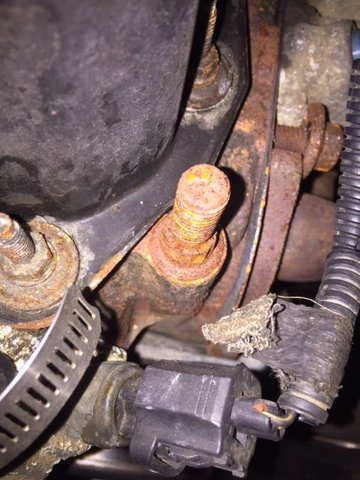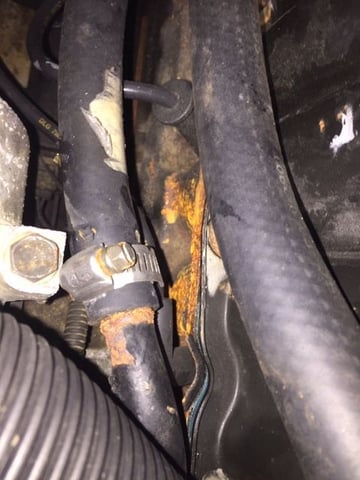Rust on Head 2 year old head bolts...
#1
I've never been afraid to risk being the dumbest guy on this forum.... But I must have done something historically dumb.
1999 XJ has been sitting still for 4 moths while youngest was away at school. He's home and we are working on getting some codes removed so we can complete MD state emissions.
Opened the hood for the first time in a long time today and saw rust on all of my newly installed head bolts - 2 years old. Also saw some where valve cover meets the head.
We just installed all of these a couple of years ago as part of a head gasket replacement and top end work... coolant system... fan replacements... new cables,,,, etc. Is this something we caused?
See 4 pics.
Thanks
Russ
1999 XJ has been sitting still for 4 moths while youngest was away at school. He's home and we are working on getting some codes removed so we can complete MD state emissions.
Opened the hood for the first time in a long time today and saw rust on all of my newly installed head bolts - 2 years old. Also saw some where valve cover meets the head.
We just installed all of these a couple of years ago as part of a head gasket replacement and top end work... coolant system... fan replacements... new cables,,,, etc. Is this something we caused?
See 4 pics.
Thanks
Russ
#3
Member
Joined: Nov 2018
Posts: 158
Likes: 2
From: Burleson, Texas
Year: 1993
Model: Cherokee (XJ)
Engine: 4.0L
I would venture to say that they are not coated/stainless and that is why it happened - just humidity. Mine (although old) are the same way.
Something like spending the extra cash on ARP would not do this but is it worth the extra money is the real question.
Now, I may be wrong and if so someone will be by shortly to straighten me out and give you sound information.
Something like spending the extra cash on ARP would not do this but is it worth the extra money is the real question.
Now, I may be wrong and if so someone will be by shortly to straighten me out and give you sound information.
#4
CF Veteran
Joined: Nov 2017
Posts: 3,700
Likes: 236
From: Groton, MA
Year: 1995
Model: Cherokee(XJ)
Engine: I6 4.0L
It's just relatively cheap hardware. Unless you used some sort of high power stripping chemical or took a heavy duty power brush to them, you didn't do it.
You can clean off the surface rust and put some kind of protectant on them if it bothers you or you intend to keep the Jeep for another 10+ years, but it's almost certainly nothing to worry about.
You can clean off the surface rust and put some kind of protectant on them if it bothers you or you intend to keep the Jeep for another 10+ years, but it's almost certainly nothing to worry about.
#6
Junior Member
Joined: Jul 2017
Posts: 87
Likes: 5
From: S.W. WA State
Year: 1989 & 1990
Model: Cherokee (XJ)
Engine: 4.0
The valve cover bolt heads seem to be just as rusted so there must have been something corrosive there.
Road salt spray perhaps?
Open the hood more often and do some cleaning and maybe wipe the non-painted metal parts with something oily once in a while. Oily surface of-course will attract dust...but hey, it's a 20 year old Jeep.....
Road salt spray perhaps?
Open the hood more often and do some cleaning and maybe wipe the non-painted metal parts with something oily once in a while. Oily surface of-course will attract dust...but hey, it's a 20 year old Jeep.....
Trending Topics
#8
Mudda Nature is not kind to unprotected metal. Also, two years is a very long time to an exposed ferrous metal fastener. ACE hardware, perhaps other stores, carries a corrosion preventative liquid by the brand name LPS. It comes in three flavors - 1, 2 & 3. Get some LPS3 and dump some into a disposable container. Then apply it to your (wire-brushed clean) fasteners with a 60-cent disposable 1-inch paint brush from Harbor Freight. It's also good stuff for painting exposed suspension parts, calipers, free-board areas of the brake rotor, and all other exposed metal parts. After cleaning away dirt and loose rust with a wire brush, just apply it - don't be stingy - and let it dry. It will do what it does pretty well for a long time if left undisturbed. It can be removed with a rag dampened with mineral spirits.
If you want to get real fancy, after wire-brushing you can paint the parts with something like POR-15, which is an impenetrable finish that continues to cure in the presence of moisture (humidity). Jay Leno hawks it. His mechanics swear by it. They also use it to coat the insides of the fuel tanks of the cars they restore. After it cures for a couple days you can wipe the parts clean and then apply LPS3.
https://www.por15.com/POR-15-Top-Coat-DTM-Paint
https://www.lpslabs.com/site_files/t.../TDS_00316.pdf
For the life of me I never could understand the lack of corrosion prevention in the design of ground vehicles. I'm an aircraft mechanic and corrosion prevention is a huge money saver, and often a safety concern. I'm quite used to inspecting for, removing and/or halting the spread of corrosion in my vehicles.
If you want to get real fancy, after wire-brushing you can paint the parts with something like POR-15, which is an impenetrable finish that continues to cure in the presence of moisture (humidity). Jay Leno hawks it. His mechanics swear by it. They also use it to coat the insides of the fuel tanks of the cars they restore. After it cures for a couple days you can wipe the parts clean and then apply LPS3.
https://www.por15.com/POR-15-Top-Coat-DTM-Paint
https://www.lpslabs.com/site_files/t.../TDS_00316.pdf
For the life of me I never could understand the lack of corrosion prevention in the design of ground vehicles. I'm an aircraft mechanic and corrosion prevention is a huge money saver, and often a safety concern. I'm quite used to inspecting for, removing and/or halting the spread of corrosion in my vehicles.
#10
Junior Member
Joined: Jun 2018
Posts: 36
Likes: 0
From: Granada, Spain
Year: 1994
Model: Cherokee (XJ)
Engine: 2.1TD
Mudda Nature is not kind to unprotected metal. Also, two years is a very long time to an exposed ferrous metal fastener. ACE hardware, perhaps other stores, carries a corrosion preventative liquid by the brand name LPS. It comes in three flavors - 1, 2 & 3. Get some LPS3 and dump some into a disposable container. Then apply it to your (wire-brushed clean) fasteners with a 60-cent disposable 1-inch paint brush from Harbor Freight. It's also good stuff for painting exposed suspension parts, calipers, free-board areas of the brake rotor, and all other exposed metal parts. After cleaning away dirt and loose rust with a wire brush, just apply it - don't be stingy - and let it dry. It will do what it does pretty well for a long time if left undisturbed. It can be removed with a rag dampened with mineral spirits.
If you want to get real fancy, after wire-brushing you can paint the parts with something like POR-15, which is an impenetrable finish that continues to cure in the presence of moisture (humidity). Jay Leno hawks it. His mechanics swear by it. They also use it to coat the insides of the fuel tanks of the cars they restore. After it cures for a couple days you can wipe the parts clean and then apply LPS3.
https://www.por15.com/POR-15-Top-Coat-DTM-Paint
https://www.lpslabs.com/site_files/t.../TDS_00316.pdf
For the life of me I never could understand the lack of corrosion prevention in the design of ground vehicles. I'm an aircraft mechanic and corrosion prevention is a huge money saver, and often a safety concern. I'm quite used to inspecting for, removing and/or halting the spread of corrosion in my vehicles.
If you want to get real fancy, after wire-brushing you can paint the parts with something like POR-15, which is an impenetrable finish that continues to cure in the presence of moisture (humidity). Jay Leno hawks it. His mechanics swear by it. They also use it to coat the insides of the fuel tanks of the cars they restore. After it cures for a couple days you can wipe the parts clean and then apply LPS3.
https://www.por15.com/POR-15-Top-Coat-DTM-Paint
https://www.lpslabs.com/site_files/t.../TDS_00316.pdf
For the life of me I never could understand the lack of corrosion prevention in the design of ground vehicles. I'm an aircraft mechanic and corrosion prevention is a huge money saver, and often a safety concern. I'm quite used to inspecting for, removing and/or halting the spread of corrosion in my vehicles.
#11
Senior Member
Joined: Nov 2012
Posts: 918
Likes: 3
From: Harrisburg, Pennsylvania
Year: 1995
Model: Cherokee
Engine: 4.0L HO
If you want to get real fancy, after wire-brushing you can paint the parts with something like POR-15, which is an impenetrable finish that continues to cure in the presence of moisture (humidity). Jay Leno hawks it. His mechanics swear by it. They also use it to coat the insides of the fuel tanks of the cars they restore.
#12
True. I put a rotary wire wheel on a die grinder and the stuff flies off of the threads. Basically, POR-15 is formulated to halt the propagation of rust on ferrous metal surfaces. It should be top-coated with a good quality enamel such as the oil-based Rustoleum products. I'm currently applying gloss black Rustoleum over the POR-15 on the undercarriage and structural components of the 98 and will do the same on my 96. LPS3 will be applied over the Rustoleum once dried. That should last for the remaining life of the vehicles and prevent any detrimental corrosion damage from occurring.
#14
Member
Joined: Nov 2018
Posts: 158
Likes: 2
From: Burleson, Texas
Year: 1993
Model: Cherokee (XJ)
Engine: 4.0L
For the life of me I never could understand the lack of corrosion prevention in the design of ground vehicles. I'm an aircraft mechanic and corrosion prevention is a huge money saver, and often a safety concern. I'm quite used to inspecting for, removing and/or halting the spread of corrosion in my vehicles.
#15
Senior Member
Joined: Nov 2012
Posts: 918
Likes: 3
From: Harrisburg, Pennsylvania
Year: 1995
Model: Cherokee
Engine: 4.0L HO
In my experience most people and the auto manufacturers see vehicles as disposable so adding something like this would be a waste of time and money. Aircraft on the other hand are usually kept many times longer than cars and, as we all know, failure is going to end up worse.





